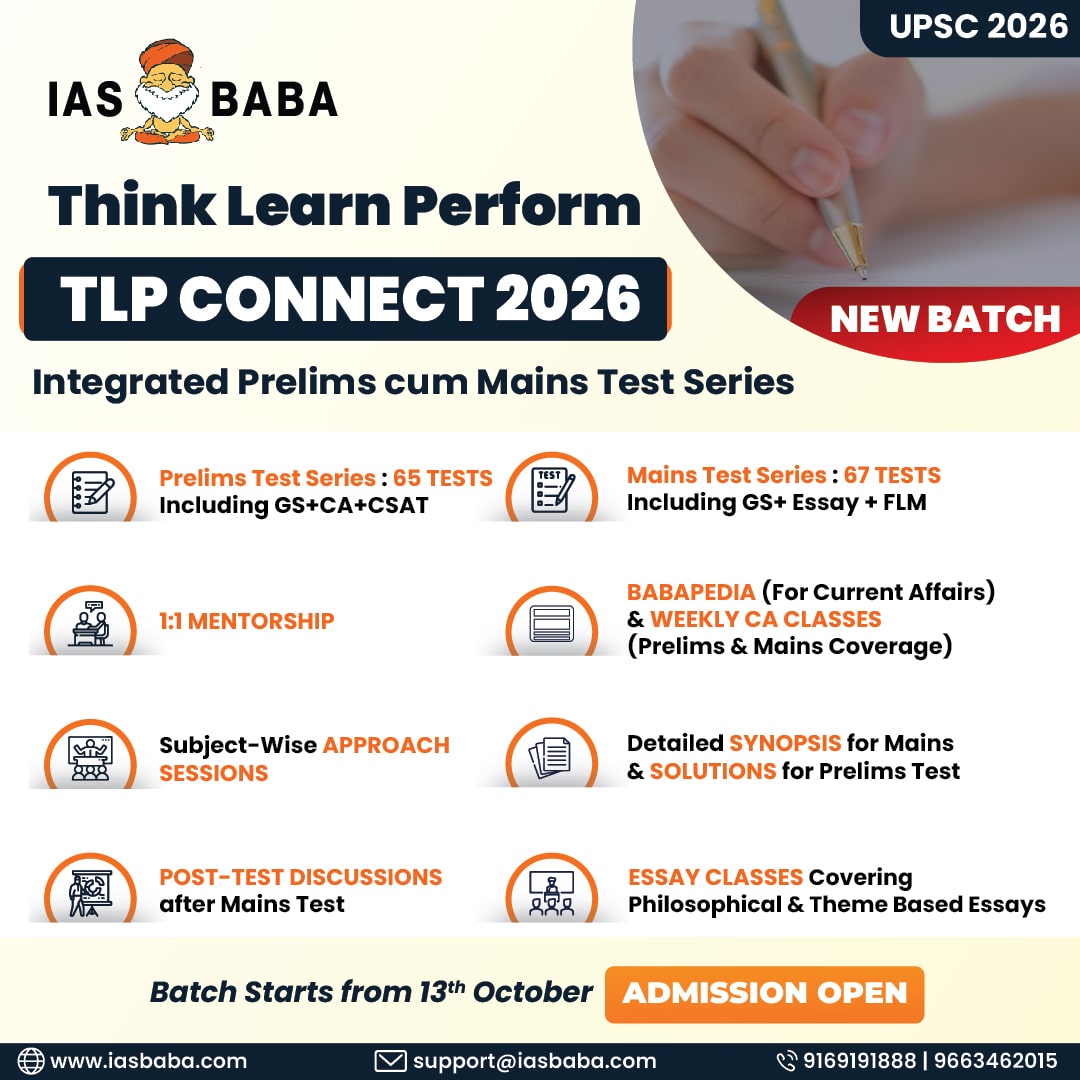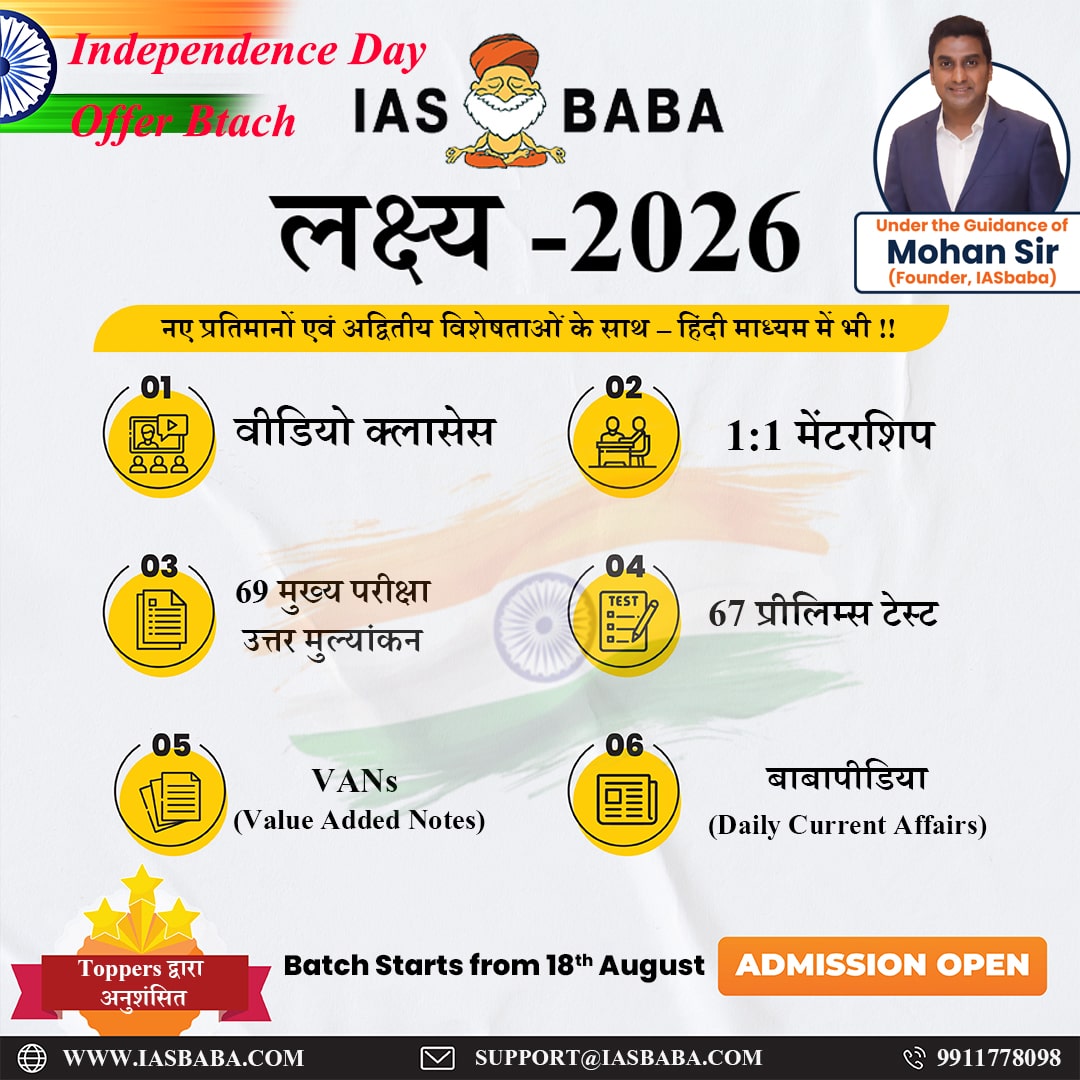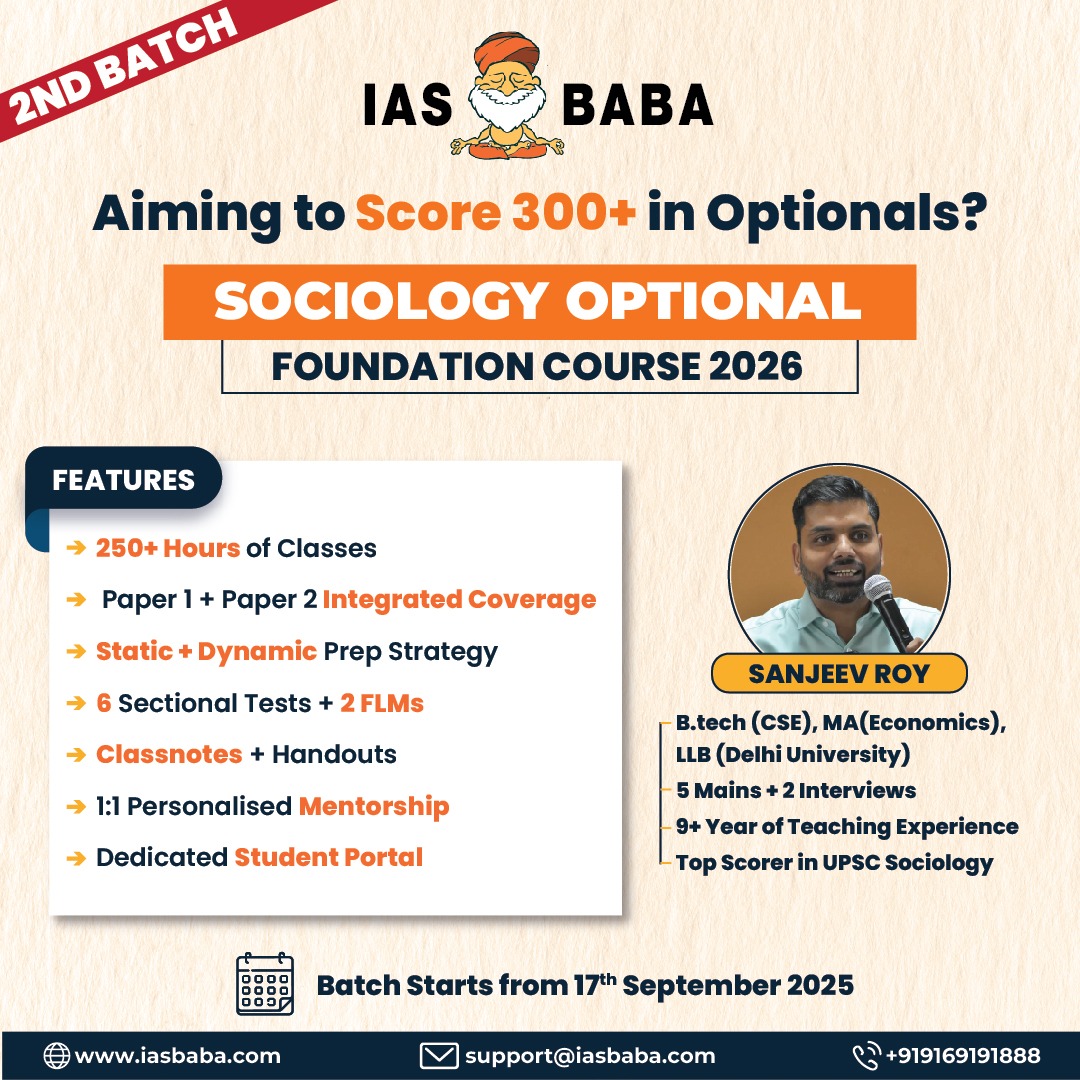IASbaba Daily Prelims Quiz
For Previous Daily Quiz (ARCHIVES) – CLICK HERE
The Current Affairs questions are based on sources like ‘The Hindu’, ‘Indian Express’ and ‘PIB’, which are very important sources for UPSC Prelims Exam. The questions are focused on both the concepts and facts. The topics covered here are generally different from what is being covered under ‘Daily Current Affairs/Daily News Analysis (DNA) and Daily Static Quiz’ to avoid duplication. The questions would be published from Monday to Saturday before 2 PM. One should not spend more than 10 minutes on this initiative.
Gear up and Make the Best Use of this initiative.
Do remember that, “the difference between Ordinary and EXTRA-Ordinary is PRACTICE!!”
Important Note:
- Don’t forget to post your marks in the comment section. Also, let us know if you enjoyed today’s test 🙂
- After completing the 5 questions, click on ‘View Questions’ to check your score, time taken, and solutions.
Test-summary
0 of 5 questions completed
Questions:
- 1
- 2
- 3
- 4
- 5
Information
To view Solutions, follow these instructions:
- Click on – ‘Start Test’ button
- Solve Questions
- Click on ‘Test Summary’ button
- Click on ‘Finish Test’ button
- Now click on ‘View Questions’ button – here you will see solutions and links.
You have already completed the test before. Hence you can not start it again.
Test is loading...
You must sign in or sign up to start the test.
You have to finish following test, to start this test:
Results
0 of 5 questions answered correctly
Your time:
Time has elapsed
You have scored 0 points out of 0 points, (0)
| Average score |
|
| Your score |
|
Categories
- Not categorized 0%
| Pos. | Name | Entered on | Points | Result |
|---|---|---|---|---|
| Table is loading | ||||
| No data available | ||||
- 1
- 2
- 3
- 4
- 5
- Answered
- Review
-
Question 1 of 5
1. Question
-
With reference to the Securities Transaction Tax (STT) in India, consider the following statements:
-
Unlike income tax or capital gains tax, STT is a tax on the act of transaction itself, and hence its incidence is independent of the trader’s profitability.
-
The proceeds from STT are shared between the Union and State Governments, similar to the Goods and Services Tax (GST).
Which of the statement(s) given above is/are correct?
Correct
-
Solution: (a).
Explanation:
- STT is a transaction-based tax, i.e., it is levied on the value of securities traded, irrespective of whether the transaction results in profit or loss. It does not tax income or gains but the act of trading itself — making it conceptually distinct from income tax or capital gains tax. Hence Statement 1 is Correct
STT is a Union tax, and its revenue goes entirely to the Consolidated Fund of India. It is not shared with States like GST, which is a concurrent tax under the Constitution (Article 246A). Hence Statement 2 is Incorrect:
Incorrect
-
Solution: (a).
Explanation:
- STT is a transaction-based tax, i.e., it is levied on the value of securities traded, irrespective of whether the transaction results in profit or loss. It does not tax income or gains but the act of trading itself — making it conceptually distinct from income tax or capital gains tax. Hence Statement 1 is Correct
STT is a Union tax, and its revenue goes entirely to the Consolidated Fund of India. It is not shared with States like GST, which is a concurrent tax under the Constitution (Article 246A). Hence Statement 2 is Incorrect:
-
-
Question 2 of 5
2. Question
-
With reference to euthanasia in India, consider the following statements:
-
Passive euthanasia involves withholding or withdrawing medical treatment that prolongs the life of a terminally ill patient, allowing natural death to occur.
-
The constitutional basis for recognizing passive euthanasia in India primarily flows from Article 21, as interpreted by the Supreme Court in the Common Cause v. Union of India (2018) judgment.
-
Under Indian law, both passive and active euthanasia are permissible provided that the patient’s family gives written consent and a medical board approves it.
Which of the statement(s) given above is/are correct?
Correct
-
Solution: (b).
Explanation:
- Passive euthanasia means withholding or withdrawing life-sustaining treatment (like ventilator or feeding tubes) to permit a natural death, rather than administering something to cause death directly. Hence Statement 1 is Correct
- The Supreme Court in Common Cause v. Union of India (2018) recognized passive euthanasia and living wills as part of the right to die with dignity under Article 21 (Right to Life). Hence Statement 2 is Correct
Active euthanasia, which involves a deliberate act to end life (like administering a lethal injection), remains illegal under the Indian Penal Code (Sections 302 and 304). Only passive euthanasia is allowed, subject to strict medical board and judicial oversight, even if family consent is present. Hence Statement 3 is Incorrect
Incorrect
-
Solution: (b).
Explanation:
- Passive euthanasia means withholding or withdrawing life-sustaining treatment (like ventilator or feeding tubes) to permit a natural death, rather than administering something to cause death directly. Hence Statement 1 is Correct
- The Supreme Court in Common Cause v. Union of India (2018) recognized passive euthanasia and living wills as part of the right to die with dignity under Article 21 (Right to Life). Hence Statement 2 is Correct
Active euthanasia, which involves a deliberate act to end life (like administering a lethal injection), remains illegal under the Indian Penal Code (Sections 302 and 304). Only passive euthanasia is allowed, subject to strict medical board and judicial oversight, even if family consent is present. Hence Statement 3 is Incorrect
-
-
Question 3 of 5
3. Question
-
Consider the following statements:
Statement I: The human immune system maintains self-tolerance primarily through mechanisms that prevent immune responses against the body’s own tissues.
Statement II: Regulatory T cells (T-regs), whose development depends on the FOXP3 gene, suppress overactive immune responses and are central to peripheral immune tolerance.
Statement III: Central tolerance in the thymus alone is sufficient to prevent autoimmune diseases in healthy individuals.
Which one of the following is correct in respect of the above statements?
Correct
-
Solution: (c)
Explanation:
- The immune system avoids self-destruction by maintaining self-tolerance, meaning it does not mount immune attacks against self-cells. Hence Statement I is Correct
- The 2025 Nobel laureates (Brunkow, Ramsdell, and Sakaguchi) discovered that regulatory T cells (T-regs), dependent on the FOXP3 gene, are essential for peripheral immune tolerance—they suppress immune overactivity and maintain balance. Hence Statement II is Correct
- Central tolerance in the thymus removes self-reactive T cells, but it is not sufficient by itself. Peripheral tolerance, mediated by regulatory T cells, is equally vital. Hence Statement III is Incorrect
Hence, only Statement II is correct, and it explains Statement I
Incorrect
-
Solution: (c)
Explanation:
- The immune system avoids self-destruction by maintaining self-tolerance, meaning it does not mount immune attacks against self-cells. Hence Statement I is Correct
- The 2025 Nobel laureates (Brunkow, Ramsdell, and Sakaguchi) discovered that regulatory T cells (T-regs), dependent on the FOXP3 gene, are essential for peripheral immune tolerance—they suppress immune overactivity and maintain balance. Hence Statement II is Correct
- Central tolerance in the thymus removes self-reactive T cells, but it is not sufficient by itself. Peripheral tolerance, mediated by regulatory T cells, is equally vital. Hence Statement III is Incorrect
Hence, only Statement II is correct, and it explains Statement I
-
-
Question 4 of 5
4. Question
-
With reference to the Lingayat philosophy, consider the following statements:
-
The Ishta Linga in Lingayat philosophy represents the presence of Shiva within each individual and serves as a means for direct, personal worship without dependence on external rituals or intermediaries.
-
Lingayat metaphysics teaches a qualified unity between Jeeva (individual soul) and Shiva (the supreme being), where liberation is attained through devotion, ethical conduct, and service to society.
Which of the statement(s) given above is/are correct?
Correct
-
Solution: (c).
Explanation:
- The Ishta Linga is the core of Lingayat worship, symbolizing the divine within each person. It signifies that every individual can directly experience God, without temple rituals or priestly mediation. Hence Statement 1 is Correct
Lingayat philosophy views Jeeva and Shiva as distinct yet inseparable, reflecting a qualified non-dual worldview. Liberation (Aikya) is achieved through devotion (Bhakti), moral life (Kayaka), and sharing (Dasoha) — integrating spirituality with social ethics. Hence Statement 2 is Correct
Incorrect
-
Solution: (c).
Explanation:
- The Ishta Linga is the core of Lingayat worship, symbolizing the divine within each person. It signifies that every individual can directly experience God, without temple rituals or priestly mediation. Hence Statement 1 is Correct
Lingayat philosophy views Jeeva and Shiva as distinct yet inseparable, reflecting a qualified non-dual worldview. Liberation (Aikya) is achieved through devotion (Bhakti), moral life (Kayaka), and sharing (Dasoha) — integrating spirituality with social ethics. Hence Statement 2 is Correct
-
-
Question 5 of 5
5. Question
-
With reference to nuclear power generation in India, consider the following pairs:
Nuclear Power Plant State I. Kakrapar Gujarat II. Kaiga Karnataka III. Narora Uttar Pradesh IV. Kudankulam Tamil Nadu How many of the pair(s) given above is/are correctly matched?
Correct
-
Solution: (d)
Explanation:
- Kakrapar Atomic Power Station (KAPS) – Gujarat. This option is correct
- Kaiga Generating Station (KGS) – Karnataka. This option is correct
- Narora Atomic Power Station (NAPS) – Uttar Pradesh. This option is correct
Kudankulam Nuclear Power Plant (KKNPP) – Tamil Nadu. This option is correct
Incorrect
-
Solution: (d)
Explanation:
- Kakrapar Atomic Power Station (KAPS) – Gujarat. This option is correct
- Kaiga Generating Station (KGS) – Karnataka. This option is correct
- Narora Atomic Power Station (NAPS) – Uttar Pradesh. This option is correct
Kudankulam Nuclear Power Plant (KKNPP) – Tamil Nadu. This option is correct
-
- Current Affairs Quiz, IAS Daily Current Affairs Quiz, IAS UPSC Current Affairs Quiz, IAS UPSC Prelims Quiz, IASbaba's Current Affairs Prelims Quiz, IASbaba's Daily Quiz, IASbaba's UPSC Quiz, Prelims Current Affairs Quiz, UPSC Current Affairs Quiz, UPSC Current Affairs Quiz IASbaba, UPSC Daily Current Affair Quiz, UPSC IAS Daily Quiz













